
Qing dynasty copper coins - situation familiar
I. Bengang site
Bengang was the area that now includes Beigang Town in Yunlin County and Xingang Township in Chiayi County. It was one of the most important harbors in Taiwan during the Qing Dynasty and one of the first areas to be developed by Han Chinese settlers. Parts of Bengang were flooded several times by the rising waters of the Beigang River, resulting in many objects being buried and preserved.
Between the end of 2001 and the beginning of 2002, the Water Resources Department of the Yunlin County Government built a new embankment on the eastern side of Beigang Town as part of its flood control efforts. Sand from along the eastern bank of the Beigang River was used in the project. At the same time, the Beigang River course was moved eastward some 50 meters. Beginning in May of 2002, every time there were heavy rains, the river rose, washing out the surrounding sand banks. When the waters receded, ancient objects would be exposed on the sand. Local residents and antique dealers rushed to collect these objects and even began digging to find more. However, if they had not acted, these objects would eventually have been washed away by the river.
In November of 2002, the National Museum of Natural Science was commissioned by the Council for Cultural Affairs to salvage the Bengang site. In January and February of the following year, an area of 143 square meters had been excavated. Findings included a well and a large number of Han Chinese objects dating to the Qing dynasty. These included bricks, tiles, potsherds, coins, hairpins, rings, earrings, copper bells, pipes, bronze mirrors, glass hairpins, glass beads, glass rings, glass bottles, game pieces, grindstones, seals, stone mortars, stone weights and inkstones.
Most of the objects were found along the eastern bank of the Beigang River approximately 250 meters north and east of a railway bridge of the Taiwan Sugar Corporation between layers of coarse black sand and gravel. The elevation is about 3 to 4 meters above sea level. On top of the coarse black sand and gravel layers are 4 to 5 meters of fine sand that had accumulated over recent centuries to form sand hills.
Most of the private collectors focused on ancient coins. From conservative estimates, some 30,000 to 50,000 coins were removed between May and December of 2002. The archaeological team from the National Museum of Natural Science found more than 1,500 complete or nearly complete coins, as well as more than 1,000 partial coins (1/2 or 1/4 intact). More than half were from the Qing Dynasty with Kang Xi Tong Bao, Qian Long Tong Bao and Jia Qing Tong Bao appearing in the largest quantities. Among them, some were from private mints. There were only small quantities of Shun Zhi Tong Bao, Yong Zheng Tong Bao, Dao Guang Tong Bao and Tong Zhi Tong Bao. In addition, there were small numbers of Zhao Wu Tong Bao and Hong Hua Tong Bao, which were the currencies used by Wu Sangui and Wu Shifan during the the Revolt of the Three Feudatories.
Relatively few coins from the Tang, Song and Ming dynasties were excavated. Those that were found had much lower weights than expected perhaps due to erosion or to counterfeiting. Tang Dynasty coins included Kai Yuan Tong Bao and Qian Yuan Zhong Bao. Most of the Song Dynasty coins that were found were from the Northern Song Dynasty. Those associated with a reign title included Xiang Fu Yuan Bao, Tian Sheng Yuan Bao, Tian Xi Tong Bao, Xi Ning Yuan Bao, Yuan Feng Tong Bao and Yuan You Tong Bao, etc. Those not associated with a reign title included Song Yuan Tong Bao, Huang Song Tong Bao and Sheng Song Yuan Bao, etc. Some emperors often changed reign titles. For example, the coins issued during the reign of Emperor Ren Zong of the Northern Song Dynasty included Tian Sheng Yuan Bao, Yuan You Yuan Bao and Huang Song Tong Bao. The coins issued during the reign of Emperor Hui Zong, also of the Northern Song Dynasty, were Sheng Song Yuan Bao and Zheng He Tong Bao. Although coins of the same issue share the same characters, these may be written in different types of script on different coins. For example, there are two types of Huang Song Tong Bao, one which features characters in regular calligraphy script and one which features seal characters. Ming Dynasty coins included Hong Wu Tong Bao, Wan Li Tong Bao and Tian Qi Tong Bao.
There were also a significant number of ancient Japanese coins and Annamese (today’s Vietnam) coins, making up about one-fifth of the total coins that were excavated. From these findings, it is clear that the people of Bengang had a thriving trade relationship with Japan and Annam. Japanese coins included the Kanei Tsuho (Kuan Yong Tong Bao) and those that imitated Yuan Feng Tong Bao. There were many types of Annamese coins, such as those minted by the government under various dynasties, as well as examples of rebel and private minting. They included Da He Tong Bao, An Fa Yuan Bao and Jing Xing Tong Bao. The characters on the obverse of many rebel and privately minted coins imitated those of the reign titles of China. However, the characters did not refer to reign titles. Scripts were often mixed and included seal characters and regular script. Annamese coins were small (20.0mm or less in diameter) and light (1.5g or less). They were in widespread circulation in Guangdong and Fujian provinces of China and in Taiwan during the Qing Dynasty.
From the more than 1,500 coins excavated from the Bengang site, 70 of the most representative were selected. The obverse and reverse of each coin have been photographed and most include an ink rubbing as well. Simple descriptions have been added to allow the public to gain a better understanding of the currency that was used in Qing Dynasty Taiwan.
II. Tang Dynasty coins
1. Kai Yuan Tong Bao(BK0345)
This coin was issued in 621 during the reign of Emperor Gao Zu. The characters on the obverse are written in a style that is based on the works of calligraphist Ou-Yang Xun. The script is in ba fen shu (a mix of regular and clerical (li shu) scripts). The characters are arranged from top to bottom and from right to left. Reverse is plain. Diameter: 25.0mm. Hole Width: 6.5mm. Thickness: 1.0mm. Weight: 3.1g. Kai Yuan does not refer to a reign title. It was the major currency used throughout the Tang Dynasty.
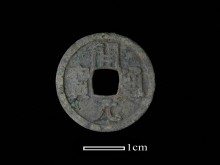
2. Qian Yuan Zhong Bao(BK0347)
This coin was issued between 758 and 760 during the Qian Yuan era of the reign of Emperor Su Zong. The characters on the obverse are written in clerical (li shu) script and are read from top to bottom and from right to left. Reverse is plain. Diameter: 22.0mm. Hole Width: 6.6mm. Thickness: 1.0mm. Weight: 1.9g. When it was initially issued, the Qian Yuan Zhong Bao was comparable to 10 Kai Yuan Tong Bao. However, due to inflation, it gradually became smaller, eventually shrinking to a size similar to that of the one wen coin.
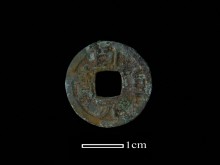
III. Song Dynasty coins
1. Song Yuan Tong Bao(BK0748)
Song Yuan Tong Bao appeared in 960 during the reign of Emperor Tai Zu of the Northern Song Dynasty. It was the first coin of the Song Dynasty. The characters on the obverse are in regular script and are read from top to bottom and from right to left. The reverse is plain. Diameter: 23.3mm. Hole Width: 5.8mm. Thickness: 0.8mm. Weight: 2.9g.

2. Xiang Fu Yuan Bao(BK1494)
This coin was introduced in the Xiang Fu era from 1008 to 1016 during the Northern Song Dynasty under Emperor Zhen Zhong. The characters on the obverse are in regular Chinese calligraphy script and are arranged in a circular pattern (in order from top to right to bottom to left). The reverse is plain. Diameter: 24.4mm. Hole Width: 5.9mm. Thickness: 1.0mm. Weight: 2.7g.

3. Tian Xi Tong Bao(BK1020)
The issue of this coin took place between 1017 and 1021 during the Tian Xi era of the reign of Emperor Zhen Zhong of the Northern Song Dynasty. The characters on the obverse are in regular Chinese calligraphy script and are arranged in a circular pattern. The reverse is plain. Diameter: 24.6mm. Hole Width: 6.5mm. Thickness: 0.6mm. Weight: 2.2g.

4. Tian Sheng Yuan Bao(BK0844)
This coin was issued during the Tian Sheng era (1023 to 1031) of the reign of Emperor Ren Zong of the Northern Song Dynasty. The characters on the obverse are arranged in a circular pattern and written in regular Chinese calligraphy script. The reverse is plain. Diameter: 24.1mm. Hole Width: 6.4mm. Thickness: 0.8mm. Weight: 2.2g.
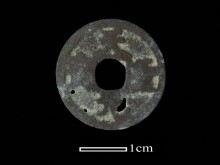
5. Jing You Yuan Bao(BK0928)
This coin was issued during the Jing You era of the reign of Emperor Ren Zong of the Northern Song Dynasty (1034-1037). The characters on the obverse are arranged in a circular pattern and appear in regular Chinese calligraphy script. The reverse is plain. Diameter: 25.4mm. Hole Width: 6.5mm. Thickness: 0.9mm. Weight: 2.9g.
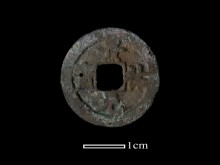
6. Huang Song Tong Bao(BK0842)
This coin was issued between 1038 and 1039 in the Bao Yuan era of the reign of Emperor Ren Zong of the Northern Song Dynasty. To avoid duplicating the “Yuan” character, this coin was named Huang Song Tong Bao. The obverse features characters in the regular Chinese calligraphy script, which are read from top to bottom and right to left. The reverse is plain. Diameter: 23.9mm. Hole Width: 6.6mm. Thickness: 1.4mm. Weight: 3.2g.
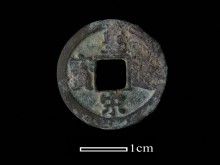
7. Xi Ning Yuan Bao(BK1257)
The Xi Ning Yuan Bao was issued by Emperor Shen Zong of the Northern Song Dynasty during the Xi Ning era of his reign (1068 to 1077). The characters on the obverse are arranged in a circular pattern and appear in regular Chinese calligraphy script. The reverse is plain. Diameter: 23.9mm. Hole Width: 5.9mm. Thickness: 1.1mm. Weight: 3.3g.

8. Yuan Feng Tong Bao(BK1258)
It was during the Yuan Feng era of the reign of Emperor Shen Zong of the Northern Song Dynasty (1078 to 1085) that this coin was issued. The characters on the obverse are arranged in a circular pattern and are written in running script in the style of Su Shi, one of the most famous calligraphers of the time. The reverse is plain. Diameter: 24.8mm. Hole Width: 6.7mm. Thickness: 1.3mm. Weight: 3.5g.
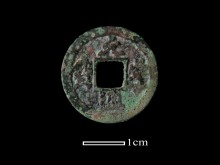
9. Yuan You Tong Bao(BK0621)
This coin was issued between 1086 and 1093, during the Yuan You era of the reign of Emperor Zhe Zong of the Northern Song Dynasty. On the obverse are characters written in the running script of Chinese calligraphy and arranged in a circular pattern. The reverse is plain. Diameter: 24.5mm. Hole Width: 6.0mm. Thickness: 1.0mm. Weight: 3.1g.
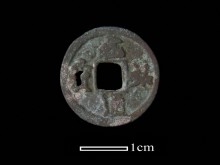
10. Shao Sheng Yuan Bao(BK0354)
This coin issued during the Shao Sheng era of the reign of Emperor Zhe Zong of the Northern Song Dynasty (1094 to 1097) features seal characters on the obverse which are arranged in a circular manner. The reverse is plain. Diameter: 23.0mm. Hole Width: 7.0mm. Thickness: 1.0mm. Weight: 2.8g.

11. Sheng Song Yuan Bao(BK0625)
Sheng Song Yuan Bao was issued in 1101 during the reign of Emperor Hui Zong of the Northern Song Dynasty. This coin is not associated with a reign title. On the obverse are seal characters arranged in a circular pattern. These seal characters are in the style of the imperial seal. The reverse is plain. Diameter: 24.0mm. Hole Width: 6.0mm. Thickness: 1.0mm. Weight: 3.0g.
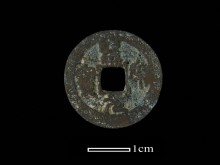
12. Zheng He Tong Bao(BK0351)
This coin was issued during the Zheng He era of Emperor Hui Zong of the Northern Song Dynasty (1111 to 1118). On the obverse are seal characters that are read from top to bottom. These seal characters are in the style of the imperial seal. The reverse is plain. Diameter: 24.0mm. Hole Width: 6.9mm. Thickness: 1.0mm. Weight: 2.3g.
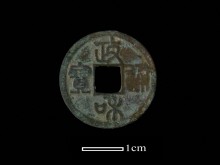
IV. Ming Dynasty coins
1. Hong Wu Tong Bao(BK1017)
Hong Wu Tong Bao was issued between 1368 and 1398 during the Hong Wu era of the reign of Emperor Tai Zu of the Ming Dynasty. On the obverse are characters arranged from top to bottom, written in the regular script of Chinese calligraphy. The reverse is plain. Diameter: 21.9mm. Hole Width: 5.8mm. Thickness: 0.9mm. Weight: 2.1g.
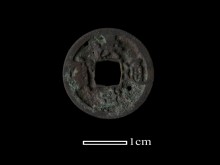
2. Wan Li Tong Bao(BK0851)
This coin was issued between 1573 and 1620 during the Wan Li era of the reign of Emperor Shen Zong of the Ming Dynasty. On the obverse are characters arranged from top to bottom, written in the regular script of Chinese calligraphy. The reverse is plain. Diameter: 25.0mm. Hole Width: 6.2mm. Thickness: 1.2mm. Weight: 3.5g.

3. Tian Qi Tong Bao(BK0755)
This coin was issued during the reign of Emperor Xi Zong of the Qing Dynasty during the Tian Qi era (1621 to 1627). On the obverse are characters arranged from top to bottom in the regular script of Chinese calligraphy. On the reverse is an inverse “Gong” character, which denotes that this coin was minted at the Ministry of Works. Diameter: 22.1mm. Hole Width: 5.4mm. Thickness: 0.6mm. Weight: 1.4g.
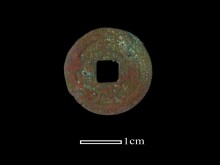
V. Qing Dynasty coins
1. Shun Zhi Tong Bao (BK0641)
This coin was issued during the Shun Zhi era (1664 to 1661) of the reign of Emperor Shi Zu of the Qing Dynasty. On the obverse are characters arranged from top to bottom in the regular script of Chinese calligraphy. The characters on the reverse are to be read from left to right. To the left of the hole is the character for Bao(寶) and to the right of the hole is the character for Quan(泉). This denotes that this coin was minted at the Bao Quan Mint. Diameter: 27.0mm. Hole Width: 6.0mm. Thickness: 0.7mm. Weight: 2.6g.

2. Kang Xi Tong Bao(BK0371)
This coin was issued during the Kang Xi era (1662 to 1722) of the reign of Emperor Shen Zu of the Qing Dynasty. On the obverse are characters arranged from top to bottom in the regular script of Chinese calligraphy. The Man Qing characters on the reverse are to be read from left to right. To the left of the hole is the character for Bao and to the right of the hole is the character for Yuan. This denotes that this coin was minted at the Bao Yuan Mint. Diameter: 22.0mm. Hole Width: 5.5mm. Thickness: 1.0mm. Weight: 3.8g.
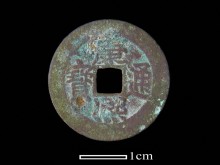
3. Yong Zheng Tong Bao (BK1132)
The issue of this coin took place during the Yong Zheng era of the reign of Emperor Shi Zong of the Qing Dynasty (1723 to 1735). On the obverse are characters arranged from top to bottom in the regular script of Chinese calligraphy. The Man Qing characters on the reverse are to be read from left to right. To the left of the hole is the character for Bao and to the right of the hole is the character for Quan. This denotes that this coin was minted at the Bao Quan Mint. Diameter: 25.4mm. Hole Width: 5.3mm. Thickness: 1.0mm. Weight: 3.4g.
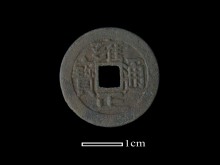
4. Qian Long Tong Bao (BK0379)
This coin was issued during the Qian Long era (1736 to 1795) of the reign of Emperor Gao Zong of the Qing Dynasty. On the obverse are characters arranged from top to bottom in the regular script of Chinese calligraphy. The Man Qing characters on the reverse are to be read from left to right. To the left of the hole is the character for Bao and to the right of the hole is the character for Zhe. This denotes that this coin was minted at the Bao Zhe Mint. Diameter: 23.0mm. Hole Width: 5.0mm. Thickness: 2.0mm. Weight: 3.7g.

5. Jia Qing Tong Bao (BK0574)
The issue of this coin took place between 1796 and 1820, otherwise known as the Jia Qing era of the reign of Emperor Ren Zong of the Qing Dynasty. On the obverse are characters arranged from top to bottom in the regular script of Chinese calligraphy. The Man Qing characters on the reverse are to be read from left to right. To the left of the hole is the character for Bao and to the right of the hole is the character for Zhi. This denotes that this coin was minted at the Bao Zhi Mint. Diameter: 22.0mm. Hole Width: 5.0mm. Thickness: 0.5mm. Weight: 1.5g.

6. Dao Guang Tong Bao (BK0438)
This coin was issued during the Dao Guang era of the reign of Emperor Xuan Zong of the Qing Dynasty (1821 to 1850). On the obverse are characters arranged from top to bottom in the regular script of Chinese calligraphy. The Man Qing characters on the reverse are to be read from left to right. To the left of the hole is the character for Bao and to the right of the hole is the character for Yun. This denotes that this coin was minted at the Bao Yun Mint. Diameter: 24.0mm. Hole Width: 6.0mm. Thickness: 0.5mm. Weight: 1.4g.

7. Xian Feng Tong Bao(BK1099)
The issue of this coin took place between 1851 and 1861, otherwise known as the Xian Feng era of the reign of Emperor Wen Zong of the Qing Dynasty. On the obverse are characters arranged from top to bottom in the regular script of Chinese calligraphy. The Man Qing characters on the reverse are to be read from left to right. To the left of the hole is the character for Bao and to the right of the hole is the character for Zhe. This denotes that this coin was minted at the Bao Zhe Mint. Diameter: 19.1mm. Hole Width: 5.4mm. Thickness: 1.3mm. Weight: 2.7g.
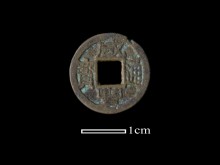
8. Tong Zhi Tong Bao(BK1401)
This coin was issued during the Tong Zhi era (1862 to 1874) of the reign of Emperor Mu Zong of the Qing Dynasty. On the obverse are characters arranged from top to bottom in the regular script of Chinese calligraphy. The Man Qing characters on the reverse are to be read from left to right. To the left of the hole is the character for Bao and to the right of the hole is the character for Zhe. This denotes that this coin was minted at the Bao Zhe Mint. Diameter: 21.7mm. Hole Width: 5.6mm. Thickness: 1.7mm. Weight: 3.4g.
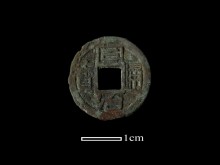
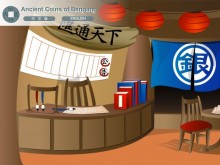
View website
Text and images are provided by National Museum of Natural Science (The Digital Museum of Nature & Culture)
Qing dynasty copper coins - remarkable, very
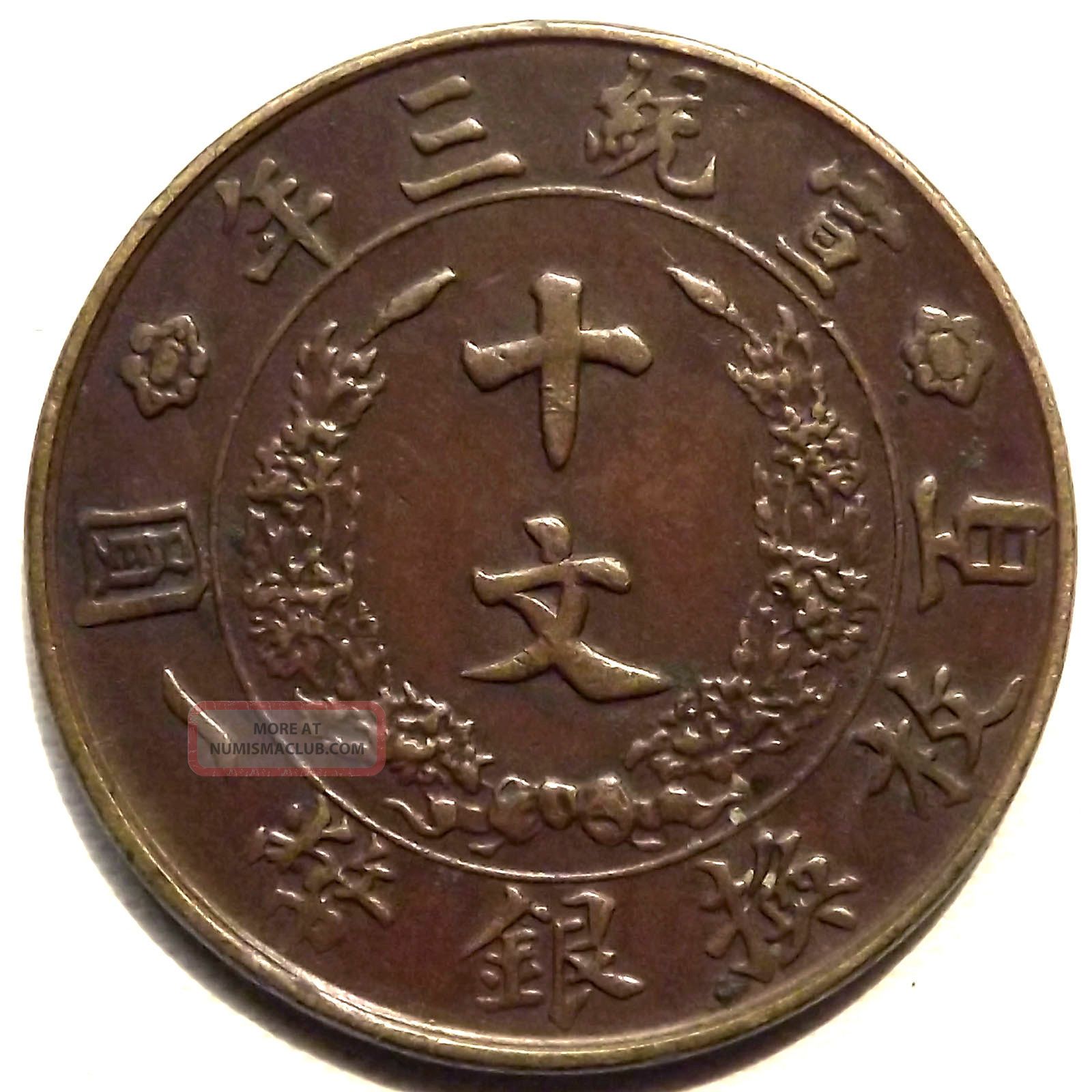
-